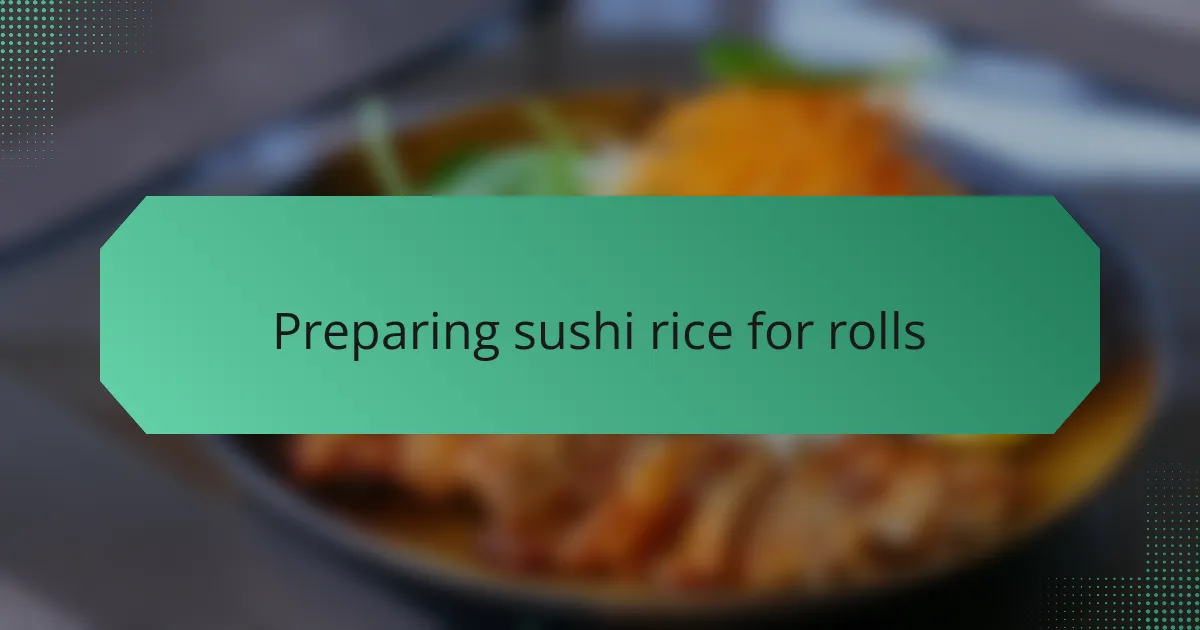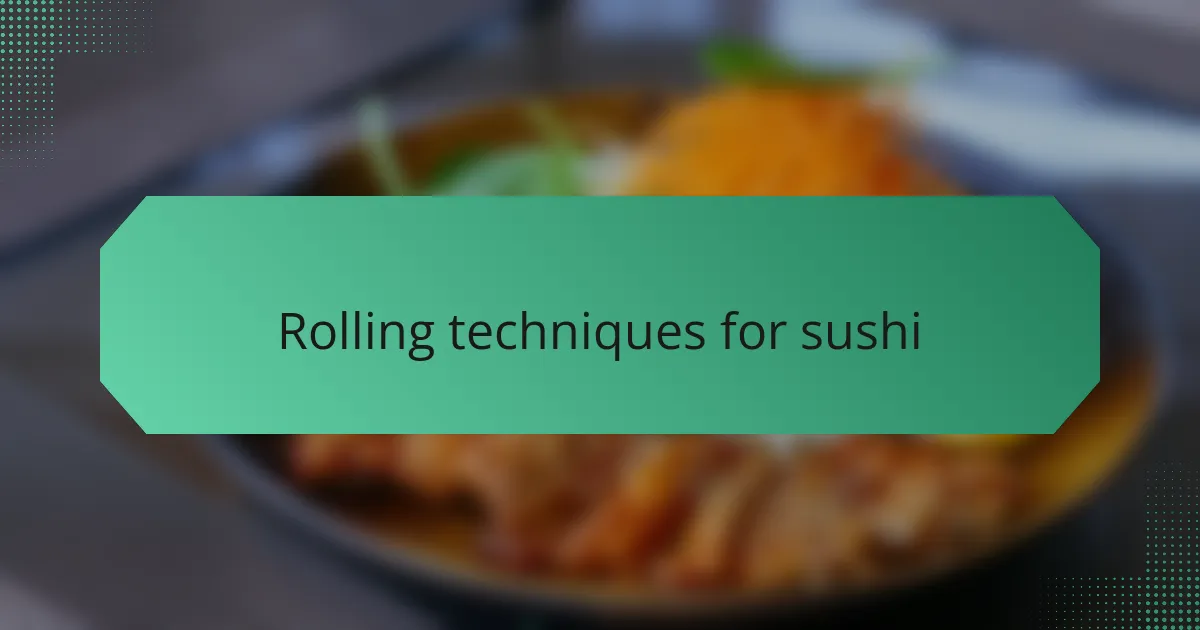Key takeaways
- Vegan sushi offers a creative, plant-based twist on traditional sushi using fresh vegetables and unique fillings, challenging conventional ideas about sushi.
- Essential ingredients include seasoned sushi rice, fresh vegetables like avocado and cucumber, and nori sheets for wrapping, ensuring flavor and texture.
- Rolling techniques are crucial; a bamboo mat aids in creating tightly rolled sushi, while balance in filling is key for optimal taste and presentation.
- Presentation enhances the eating experience; serving on simple dishes showcases vibrant colors, and storing sushi properly maintains its freshness.

What is vegan sushi
Vegan sushi is a delightful twist on the traditional Japanese dish, crafted entirely without any animal products. Instead of fish and seafood, it features fresh vegetables, fruits, and plant-based ingredients that burst with flavor and texture. Have you ever been surprised by how vibrant and satisfying a simple avocado or marinated mushroom can be inside a sushi roll?
For me, discovering vegan sushi was a game changer. It opened my eyes to just how creative and diverse plant-based cooking can be. Each roll becomes a canvas, inviting endless experimentation with colors and tastes while staying true to vegan principles.
What makes vegan sushi so special? It’s more than just food—it’s a mindful, tasty experience that challenges the idea that sushi has to involve fish. This idea always makes me smile, knowing that deliciousness doesn’t have boundaries, just possibilities.

Essential ingredients for vegan sushi
When I first started making vegan sushi, I quickly realized that choosing the right ingredients was everything. Sushi rice, seasoned with a hint of rice vinegar and a touch of sugar, forms the perfect sticky base that holds everything together. Without this classic foundation, the rolls just don’t have that satisfying texture and subtle tang that make sushi so enjoyable.
Of course, fresh veggies are the heart and soul here. Crisp cucumber, creamy avocado, and vibrant bell peppers bring texture, color, and a burst of natural flavors that excite my palate every time I bite into a roll. Sometimes, I even add pickled radish or marinated shiitake mushrooms for that extra umami punch. Have you ever noticed how a simple slice of avocado can transform a roll from ordinary to indulgent? That’s the magic I chase in my kitchen.
Nori sheets might seem humble, but they’re absolutely essential for wrapping up the whole experience. Each time I gently press the sticky rice and fillings onto the seaweed, I feel this connection to tradition, even though my ingredients are purely plant-based. It’s funny how something so thin and simple can hold so much together—both literally and emotionally, as I craft each roll with care.

Preparing sushi rice for rolls
Getting the sushi rice just right is where my sushi journey truly begins. I’ve learned that rinsing the rice thoroughly until the water runs clear is key—it removes excess starch and helps achieve that perfect sticky yet fluffy texture. Have you ever been frustrated with rice that’s too clumpy or too dry? Trust me, this simple step makes all the difference.
Once the rice is cooked, seasoning it with a blend of rice vinegar, sugar, and a pinch of salt is like adding a sprinkle of magic. I remember the first time I mixed the seasoning in while the rice was still warm; the aroma instantly lifted my spirits and made me excited for the rolls to come. Balancing those flavors creates that subtle tang and slight sweetness that sushi rice is famous for, and it’s honestly comforting to prepare something so fundamental with care.
Then comes the cooling process, which feels like waiting for a good story to unfold. Spreading the rice out gently in a wooden or glass bowl and fanning it not only cools it down but also gives it that shiny finish. I often find myself savoring the moment, appreciating how each grain glistens—a small but satisfying reward before the rolling fun begins. Have you noticed how such a simple step can elevate the whole experience? For me, it’s those little rituals that make vegan sushi so special.

Selecting and preparing fillings
Choosing the fillings always feels like the most exciting part for me. I like to pick vibrant vegetables that contrast nicely in both texture and flavor—think crunchy cucumber, silky avocado, and sweet roasted red pepper. It’s amazing how these simple ingredients, when prepped thoughtfully, can create such a satisfying bite.
Preparing the fillings requires attention to detail. I often marinate mushrooms or lightly pickle daikon to add that umami depth and a zing of acidity. Have you ever noticed how a bit of tang can make all the difference? Seasoning these plant-based ingredients transforms them from just “good” to unforgettable.
Sometimes, I experiment with how I cut the veggies—thin strips for elegance or slightly thicker pieces for a hearty feel. It might sound minor, but the way you slice your fillings affects the roll’s texture and even how the flavors blend. For me, this hands-on process is where creativity and mindfulness meet in the kitchen.

Rolling techniques for sushi
When I first learned to roll sushi, it felt like a delicate dance between my hands and the ingredients. Using a bamboo mat makes all the difference—it guides the roll gently without squashing the fillings. Have you ever tried rolling freehand? I did once, and let’s just say my sushi looked more like an abstract art piece than a neat roll!
One trick I love is to keep the rice layer thin and even over the nori. It might seem tricky at first, but spreading it just right prevents the roll from bursting open when you slice it. I found that a little practice with gentle, consistent pressure on the mat really helps get those clean, tight rolls every time.
Sometimes I get asked, “How tight should I roll?” From my experience, firm but not too tight is the sweet spot. Pressing hard enough keeps everything together but not so much that the roll turns dense or squished. It’s like a careful balance—one that grows with each roll you make and makes the whole process feel almost meditative.

Personal tips for perfect rolls
One personal tip I swear by is to keep your knife wet and sharp when slicing the rolls. Nothing ruins the perfect shape faster than a dull knife dragging through sticky rice and veggies. Have you ever struggled to get clean cuts, only to end up with a messy, squished roll? Trust me, this small detail instantly elevates the presentation and makes serving so much more satisfying.
Another thing I’ve learned from experience is to avoid overfilling your rolls. It’s tempting to pile on every favorite ingredient, but too much stuffing makes rolling nearly impossible and the final bite less enjoyable. I remind myself that balance is key—each ingredient should harmonize rather than overpower, turning every mouthful into a well-composed flavor adventure.
Finally, don’t rush the process. I find that taking my time—rolling slowly and mindfully—creates a connection to the food that’s almost calming. Have you noticed how cooking can be a form of meditation? When I roll each sushi piece carefully, it feels like a moment just for me, and the results always taste better because of it.

Serving and storing vegan sushi
When it comes to serving vegan sushi, I always like to present the rolls on a simple wooden board or a clean white plate—something that lets the vibrant colors of the vegetables shine. Have you ever noticed how much the right presentation adds to the experience? For me, it’s like setting the stage for the flavor show that’s about to happen.
Storing leftover vegan sushi can be a bit tricky because the rice tends to harden quickly in the fridge. From my experience, wrapping the rolls tightly in plastic wrap and placing them in an airtight container helps preserve their freshness longer. I’ve learned the hard way that eating sushi straight after making it tastes best—so if you must store, try to enjoy it within 24 hours for that delicate texture to remain.
Sometimes, I wonder if reheating sushi even makes sense, and honestly, I tend to avoid it altogether because the texture changes dramatically. Instead, I’ll snack on the tougher pieces cold or turn them into a quick sushi bowl with extra veggies. It’s a little reminder that flexibility in serving and storing can make the whole vegan sushi adventure even more enjoyable.